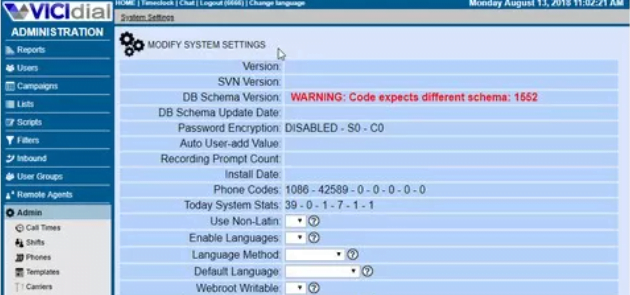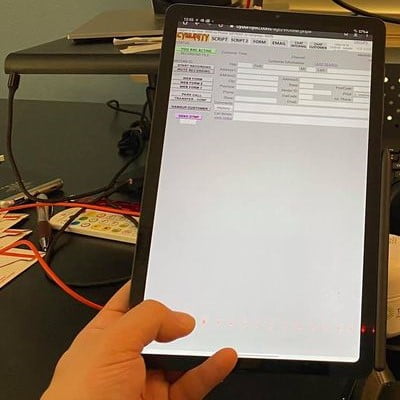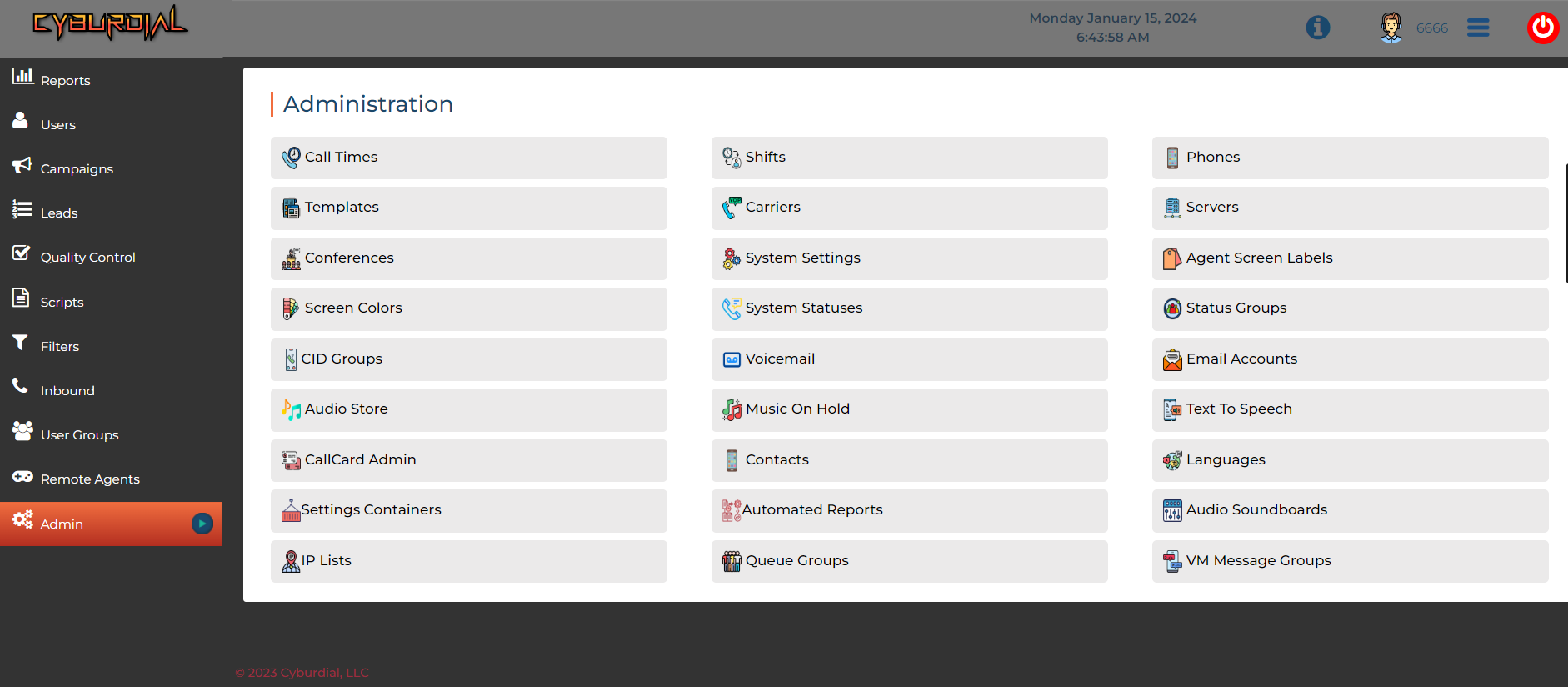How to – Vicibox 9 Scratch Install: OpenSuse 15.1
Here are the steps I used to do a vicibox 9 scratch install on Leap 15.1
###This is going to help you install Vicidial 9.0.2 on OpenSuSE 15.1 on an Amazon AWS Lightsail Virtual Server###
###First open an account on AWS and create an instance on Lightsail, choose linux, os only, opensuse.
###once its started, click on manage, then go to networking and create a static ip, attach it.
###SSH to the server, you will need to have a ssh key to do this, download the .pem file from amazon and use puttygen to convert it, ###instructions are there in lightsail
###Now is where it starts and i will just be telling you the commands to run
- sudo -i
- zypper install kernel*
- press # 2 for all 4 choices it gives you
- zypper ar https://download.opensuse.org/repositories/home:vicidial:asterisk-13/openSUSE_Leap_15.1/home:vicidial:asterisk-13.repo
- zypper ref
- zypper up
- zypper install asterisk
- reboot
- sed -i ‘s/SELINUX=enforcing/SELINUX=disabled/g’ /etc/selinux/semanage.conf
sudo -i
zypper install kernel*
press # 2 for all 4 choices it gives you
zypper ar https://download.opensuse.org/repositories/home:vicidial:asterisk-13/openSUSE_Leap_15.1/home:vicidial:asterisk-13.repo
zypper ar https://download.opensuse.org/repositories/home:/vicidial/openSUSE_Leap_15.1/home:vicidial.repo
zypper ref
zypper up
zypper install asterisk
reboot
sed -i 's/SELINUX=enforcing/SELINUX=disabled/g' /etc/selinux/semanage.conf
***Add Swap File
- mkdir -p /var/lib/swap
- dd if=/dev/zero of=/var/lib/swap/swapfile bs=1M count=1024
- mkswap /var/lib/swap/swapfile
- swapon /var/lib/swap/swapfile
- cat /proc/swaps
***Add Swap into startup
- vim /etc/fstab
- Type “i”
- Add a new line below what’s there
- COPY whats in quotes – “/var/lib/swap/swapfile swap swap defaults 0 0” Press CNTL+C
- Type what’s in quotes – “:wq”
- Press Enter
###installing dependencies
- zypper install make patch gcc gcc-c++ subversion php php-devel php-gd gd-devel php-mbstring php-mcrypt php-imap php-ldap php-mysql php-odbc php-pear php-xml php-xmlrpc curl curl-devel perl-libwww-perl ImageMagick libxml2 libxml2-devel httpd libpcap libpcap-devel libnet ncurses ncurses-devel screen mysql-devel ntp mutt wget nano unzip sipsak sox libuuid-devel
- zypper install sqlite3-devel
- zypper install mariadb-server mariadb
- zypper install httpd php-common php-pdo mod_ssl perl-DBI perl-DBD-MySQL perl-Digest-HMAC perl-YAML
- zypper install perl-ExtUtils-ParseXS perl-NetAddr-IP perl-Crypt-SSLeay perl-Curses perl-DBD-Pg perl-Module-ScanDeps perl-Text-CSV perl-HTML-Template perl-IO-Compress perl-Text-Glob perl-Jcode perl-Test-Script perl-Archive-Tar perl-Test-Base perl-OLE-Storage_Lite perl-Archive-Zip perl-Net-Server perl-Convert-ASN1 perl perl-Compress-Raw-Zlib perl-Digest-SHA1 perl-Data-Dumper perl-Error perl-ExtUtils-CBuilder perl-Test-Tester perl-Parse-RecDescent perl-Spiffy perl-IO-Zlib perl-Module-Build perl-HTML-Parser perl-Net-SSLeay perl-Proc-ProcessTable perl-TermReadKey perl-Term-ReadLine-Gnu perl-Digest-SHA perl-Tk perl-Net-SNMP perl-Test-NoWarnings perl-XML-Writer perl-Proc-PID-File perl-Compress-Raw-Bzip2 perl-libwww-perl perl-XML-Parser perl-File-Remove perl-Parse-CPAN-Meta perl-Set-Scalar perl-Probe-Perl perl-File-Which perl-Package-Constants perl-Module-Install perl-File-HomeDir perl-Spreadsheet-ParseExcel perl-Mail-Sendmail
- zypper install perl-Spreadsheet-XLSX asterisk-perl perl-version perl-Crypt-DES perl-URI perl-Net-Daemon perl-IO-stringy perl-YAML-Tiny perl-HTML-Tagset perl-Socket6 perl-BSD-Resource perl-IPC-Run3 perl-Text-CSV_XS perl-Unicode-Map perl-Net-Telnet perl-PAR-Dist perl-Date-Manip perl-JSON perl-rrdtool lame screen iftop dahdi-linux-devel perl-GD
###preparing for the next part with MCPAN
- perl -MCPAN -e ‘my $c = “CPAN::HandleConfig”; $c->load(doit => 1, autoconfig => 1); $c->edit(prerequisites_policy => “follow”); $c->edit(build_requires_install_policy => “yes”); $c->commit’
- cpan -i String::CRC Tk::TableMatrix Net::Address::IP::Local Term::ReadLine::Gnu Spreadsheet::Read Net::Address::IPv4::Local RPM::Specfile Spreadsheet::XLSX Spreadsheet::ReadSXC
- cpan MD5 Digest::MD5 Digest::SHA1 Bundle::CPAN Pod::Usage Getopt::Long DBI DBD::mysql Net::Telnet Time::HiRes Net::Server Mail::Sendmail Unicode::Map Jcode Spreadsheet::WriteExcel OLE::Storage_Lite Proc::ProcessTable IO::Scalar Scalar::Util Spreadsheet::ParseExcel Archive::Zip Compress::Raw::Zlib Spreadsheet::XLSX Test::Tester Spreadsheet::ReadSXC Text::CSV Test::NoWarnings Text::CSV_PP File::Temp Text::CSV_XS Spreadsheet::Read LWP::UserAgent HTML::Entities HTML::Strip HTML::FormatText HTML::TreeBuilder Switch Time::Local MIME::POP3Client Mail::IMAPClient Mail::Message IO::Socket::SSL readline
###copy and paste this at the same time:
- cd /usr/bin/
- curl -LOk http://xrl.us/cpanm
- chmod +x cpanm
- cpanm -f File::Which
- cpanm -f File::HomeDir
- cpanm CPAN::Meta::Requirements
- cpanm -f CPAN
- cpanm YAML
- cpanm MD5
- cpanm Digest::MD5
- cpanm Digest::SHA1
- cpanm Bundle::CPAN
- cpanm -f DBD::mysql
- cpanm Curses
- cpanm Getopt::Long
- cpanm Net::Domain
- cpanm Term::ReadKey
- cpanm Term::ANSIColor
- cpanm HTML::FormatText
- cpanm MIME::Decoder
- cpanm Mail::POP3Client
- cpanm User::Identity –force
- cpanm Mail::Message
- cpanm Crypt::Eksblowfish::Bcrypt
###lets add mysql(mariadb) and apache2 as services to autostart
- systemctl start mariadb; systemctl enable mariadb; systemctl start apache2; systemctl enable apache2
###reboot the pc
***Asterisk PERL Module 0.8 Installation – Zypper in asterisk-perl
- cd /usr/src/
- wget http://download.vicidial.com/required-apps/asterisk-perl-0.08.tar.gz
- tar -zxf asterisk-perl-0.08.tar.gz
- cd asterisk-perl-0.08
- perl Makefile.PL && make all && make install
***Install Jansson
- cd /usr/src/
- wget http://www.digip.org/jansson/releases/jansson-2.9.tar.gz
- tar -zvxf jansson-2.9.tar.gz
- cd jansson-2.9
- ./configure && make clean && make && make install
- ldconfig
- rm *.tar.gz
***Install Asterisk – Dadhi and libpri
- mkdir /usr/src/asterisk
- cd /usr/src/asterisk
- wget http://downloads.asterisk.org/pub/telephony/libpri/libpri-current.tar.gz
- wget http://downloads.asterisk.org/pub/telephony/dahdi-linux-complete/dahdi-linux-complete-current.tar.gz
- wget http://download.vicidial.com/required-apps/asterisk-13.29.2-vici.tar.gz
- tar xzf asterisk-*
- tar xzf dahdi-linux-complete-*
- tar xzf libpri-*
- cd /usr/src/asterisk/dahdi-linux-complete-3.1.0+3.1.0/
- rpm -i https://rpmfind.net/linux/opensuse/update/leap/15.1/oss/noarch/kernel-devel-4.12.14-lp151.28.48.1.noarch.rpm
- make && make install
- cd /usr/src/asterisk/libpri-1.6.0
- make clean
- make
- make install
- cd /usr/src/asterisk/asterisk-13.29.2/
- ./configure –libdir=/usr/lib64
- make clean
- make menuselect*
- !!!*MAKE SURE TO scroll down to Applications, press enter, scroll down to > App.MeetME press space bar so you see: [*] and press x to save and exit
- make && make install && make samples
- chkconfig asterisk on
***DataBase Creation
- mysql -p
- press enter for no password
- CREATE DATABASE `asterisk` DEFAULT CHARACTER SET utf8 COLLATE utf8_unicode_ci;
- CREATE USER ‘cron’@’localhost’ IDENTIFIED BY ‘1234’;
- GRANT SELECT,INSERT,UPDATE,DELETE,LOCK TABLES on asterisk.* TO cron@’%’ IDENTIFIED BY ‘1234’;
- GRANT SELECT,INSERT,UPDATE,DELETE,LOCK TABLES on asterisk.* TO cron@localhost IDENTIFIED BY ‘1234’;
- GRANT RELOAD ON *.* TO cron@’%’;
- GRANT RELOAD ON *.* TO cron@localhost;
- flush privileges;
- quit
***Install ViciDial
- mkdir /usr/src/astguiclient
- cd /usr/src/astguiclient
- svn checkout svn://svn.eflo.net:3690/agc_2-X/trunk
- cd trunk
- perl install.pl
##make sure to change web directory to /srv/www/htdocs and to put your public ip, and to put 13.X for asterisk version
***Import MySQL Settings
- mysql -u root -p
- SET GLOBAL connect_timeout=60;
- use asterisk;
- \. /usr/src/astguiclient/trunk/extras/MySQL_AST_CREATE_tables.sql
- \. /usr/src/astguiclient/trunk/extras/first_server_install.sql
- ALTER TABLE phones
- ALTER template_id SET DEFAULT ”;
- \. /usr/src/astguiclient/trunk/extras/sip-iax_phones.sql
- quit
/usr/share/astguiclient/ADMIN_area_code_populate.pl
***Edit /etc/rc.local to contain the following code (enter vi /etc/rc.local to edit with vi, nano /etc/rc.local to edit with nano, ed /etc/rc.local to edit with sed… choose an editor to your liking):
- #!/bin/sh
- #
- # This script will be executed *after* all the other init scripts.
- # You can put your own initialization stuff in here if you don’t
- # want to do the full Sys V style init stuff.
- touch /var/lock/subsys/local
- # OPTIONAL enable ip_relay(for same-machine trunking and blind monitoring)
- /usr/share/astguiclient/ip_relay/relay_control start 2>/dev/null 1>&2
- # Disable console blanking and powersaving
- /usr/bin/setterm -blank
- /usr/bin/setterm -powersave off
- /usr/bin/setterm -powerdown
- ### start up the MySQL server
- systemctl start mariadb.service systemctl enable mariadb.service
- ### start up the apache web server
- systemctl start apache2 systemctl enable apache2
- ### roll the Asterisk logs upon reboot /usr/share/astguiclient/ADMIN_restart_roll_logs.pl
- ### clear the server-related records from the database /usr/share/astguiclient/AST_reset_mysql_vars.pl
- ### load dahdi drivers
- modprobe dahdi
- /usr/sbin/dahdi_cfg -vvvvvvvvvvvvv
- ### sleep for 20 seconds before launching Asterisk
- sleep 20
- ### start up asterisk
- /usr/share/astguiclient/start_asterisk_boot.pl

***Adding to Crontab
crontab -e
**Once it opens, Press “i” and then paste the following into crontab:
- ### recording mixing/compressing/ftping scripts
- #0,3,6,9,12,15,18,21,24,27,30,33,36,39,42,45,48,51,54,57 * * * * /usr/share/astguiclient/AST_CRON_audio_1_move_mix.pl
- 0,3,6,9,12,15,18,21,24,27,30,33,36,39,42,45,48,51,54,57 * * * * /usr/share/astguiclient/AST_CRON_audio_1_move_mix.pl –MIX
- 0,3,6,9,12,15,18,21,24,27,30,33,36,39,42,45,48,51,54,57 * * * * /usr/share/astguiclient/AST_CRON_audio_1_move_VDonly.pl
- 1,4,7,10,13,16,19,22,25,28,31,34,37,40,43,46,49,52,55,58 * * * * /usr/share/astguiclient/AST_CRON_audio_2_compress.pl –GSM
- #2,5,8,11,14,17,20,23,26,29,32,35,38,41,44,47,50,53,56,59 * * * * /usr/share/astguiclient/AST_CRON_audio_3_ftp.pl –GSM
- ### keepalive script for astguiclient processes
- * * * * * /usr/share/astguiclient/ADMIN_keepalive_ALL.pl –cu3way
- ### kill Hangup script for Asterisk updaters * * * * * /usr/share/astguiclient/AST_manager_kill_hung_congested.pl
- ### updater for voicemail
- * * * * * /usr/share/astguiclient/AST_vm_update.pl
- ### updater for conference validator
- * * * * * /usr/share/astguiclient/AST_conf_update.pl
- ### flush queue DB table every hour for entries older than 1 hour 11
- * * * * /usr/share/astguiclient/AST_flush_DBqueue.pl -q
- ### fix the vicidial_agent_log once every hour and the full day run at night 33
- * * * * /usr/share/astguiclient/AST_cleanup_agent_log.pl 50 0
- * * * /usr/share/astguiclient/AST_cleanup_agent_log.pl –last-24hours
- ## uncomment below if using QueueMetrics
- #*/5 * * * * /usr/share/astguiclient/AST_cleanup_agent_log.pl –only-qm-live-call-check
- ## uncomment below if using Vtiger #1 1
- * * * /usr/share/astguiclient/Vtiger_optimize_all_tables.pl –quiet
- ### updater for VICIDIAL hopper
- * * * * * /usr/share/astguiclient/AST_VDhopper.pl -q
- ### adjust the GMT offset for the leads in the vicidial_list table
- 1 1,7 * * * /usr/share/astguiclient/ADMIN_adjust_GMTnow_on_leads.pl –debug
- ### reset several temporary-info tables in the database
- 2 1 * * * /usr/share/astguiclient/AST_reset_mysql_vars.pl
- ### optimize the database tables within the asterisk database
- 3 1 * * * /usr/share/astguiclient/AST_DB_optimize.pl
- ## adjust time on the server with ntp 30
- * * * * /usr/sbin/ntpdate -u pool.ntp.org 2>/dev/null 1>&2
- ### VICIDIAL agent time log weekly and daily summary report generation
- 2 0 * * 0 /usr/share/astguiclient/AST_agent_week.pl 22 0
- * * * /usr/share/astguiclient/AST_agent_day.pl
- ### VICIDIAL campaign export scripts (OPTIONAL)
- #32 0 * * * /usr/share/astguiclient/AST_VDsales_export.pl
- #42 0 * * * /usr/share/astguiclient/AST_sourceID_summary_export.pl
- ### remove old recordings more than 7 days old #24 0
- * * * /usr/bin/find /var/spool/asterisk/monitorDONE -maxdepth 2 -type f -mtime +7 -print | xargs rm -f
- ### roll logs monthly on high-volume dialing systems
- #30 1 1 * * /usr/share/astguiclient/ADMIN_archive_log_tables.pl
- ### remove old vicidial logs and asterisk logs more than 2 days old
- 28 0 * * * /usr/bin/find /var/log/astguiclient -maxdepth 1 -type f -mtime +2 -print | xargs rm -f 29 0
- * * * /usr/bin/find /var/log/asterisk -maxdepth 3 -type f -mtime +2 -print | xargs rm -f
- 30 0 * * * /usr/bin/find / -maxdepth 1 -name “screenlog.0*” -mtime +4 -print | xargs rm -f
- ### cleanup of the scheduled callback records
- 25 0 * * * /usr/share/astguiclient/AST_DB_dead_cb_purge.pl –purge-non-cb -q
- ### GMT adjust script – uncomment to enable
- #45 0 * * * /usr/share/astguiclient/ADMIN_adjust_GMTnow_on_leads.pl –list-settings
- ### Dialer Inventory Report
- 1 7 * * * /usr/share/astguiclient/AST_dialer_inventory_snapshot.pl -q –override-24hours
- ### inbound email parser
- * * * * * /usr/share/astguiclient/AST_inbound_email_parser.pl
!!!!END CRONTAB HERE
reboot
###once it restarts, type “yast” go to network services > http, on the first screen tab to next, then second screen enable all 3 modules(php, python and perl) and then keep going next on the last pages until u get to finish.
vim /etc/asterisk/manager.conf
find enabled=no and change to yes
save and restart
http://127.0.0.1/vicidial/admin.php
Enjoy!!!
Link to easily copy these commands: https://textuploader.com/1qfh9
Or if you prefer the Video version, check our our friend Harolds youtube:
-Nox






















